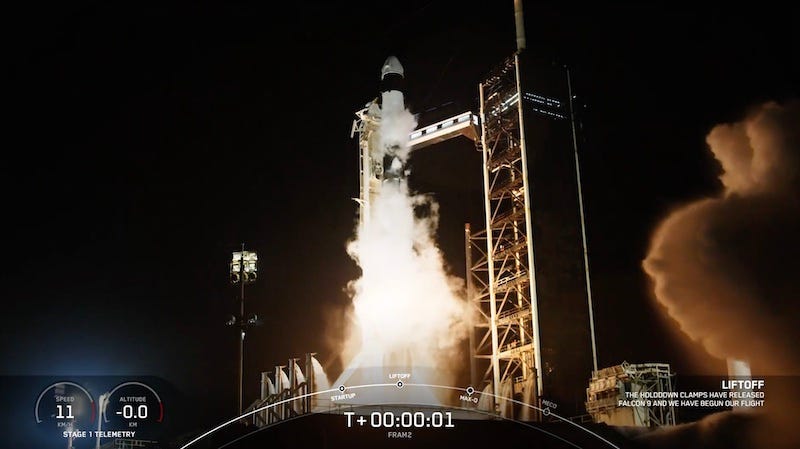On Monday, March 31 at 9:46 p.m. ET, a SpaceX Falcon 9 launched Fram2 to a polar orbit from Launch Complex 39A at NASA’s Kennedy Space Center in Florida. Following stage separation, Falcon 9’s first stage landed on the A Shortfall of Gravitas droneship stationed in the Atlantic Ocean.
During their multi-day mission, Dragon and the crew will explore Earth from a polar orbit and fly over Earth’s polar regions for the first time. They will also conduct 22 research designed to help advance humanity’s capabilities for long-duration space exploration and understanding of human health in space.
Throughout Fram2’s time on-orbit, the crew are planning to take the first x-ray in space, perform exercise studies to maintain muscle and skeletal mass, and grow mushrooms in microgravity. Additionally, after safely returning to Earth, the crew plans to exit from the Dragon spacecraft without additional medical and operational assistance, helping researchers characterize the ability of astronauts to perform unassisted functional tasks after short and long durations in space.
In an announcement posted by SpaceX last August, the company said that Fram2 is the first human spaceflight mission to explore Earth from a polar orbit and fly over the Earth’s polar regions for the first time. Named in honor of the ship that helped explorers first reach Earth’s Arctic and Antarctic regions, Fram2 is commanded by Chun Wang, an entrepreneur and adventurer from Malta. Wang aims to use the mission to highlight the crew’s explorational spirit, bring a sense of wonder and curiosity to the larger public, and highlight how technology can help push the boundaries of exploration of Earth and through the mission’s research.
Joining Wang on the mission is a crew of international adventurers: Norway’s Jannicke Mikkelsen, vehicle commander; Australia’s Eric Philips, vehicle pilot; and Germany’s Rabea Rogge, mission specialist. This will be the first spaceflight for each of the crewmembers.
Throughout the 3-to-5-day mission, the crew plans to observe Earth’s polar regions through Dragon’s cupola at an altitude of 425 – 450 km (≈265-280 miles), leveraging insight from space physicists and citizen scientists to study unusual light emissions resembling auroras. The crew will study green fragments and mauve ribbons of continuous emissions comparable to the phenomenon known as STEVE (Strong Thermal Emission Velocity Enhancement), which has been measured at an altitude of approximately 400 - 500 km (≈250-310 miles) above Earth’s atmosphere. The crew will also work with SpaceX to conduct a variety of research to better understand the effects of spaceflight on the human body, which includes capturing the first human x-ray images in space, Just-in-Time training tools, and studying the effects of spaceflight on behavioral health, all of which will help in the development of tools needed to prepare humanity for future long-duration spaceflight.





